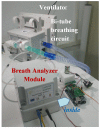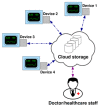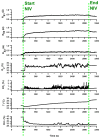A Low-Cost Breath Analyzer Module in Domiciliary Non-Invasive Mechanical Ventilation for Remote COPD Patient Monitoring
- PMID: 31991608
- PMCID: PMC7038329
- DOI: 10.3390/s20030653
A Low-Cost Breath Analyzer Module in Domiciliary Non-Invasive Mechanical Ventilation for Remote COPD Patient Monitoring
Abstract
Smart Breath Analyzers were developed as sensing terminals of a telemedicine architecture devoted to remote monitoring of patients suffering from Chronic Obstructive Pulmonary Disease (COPD) and home-assisted by non-invasive mechanical ventilation via respiratory face mask. The devices based on different sensors (CO2/O2 and Volatile Organic Compounds (VOCs), relative humidity and temperature (R.H. & T) sensors) monitor the breath air exhaled into the expiratory line of the bi-tube patient breathing circuit during a noninvasive ventilo-therapy session; the sensor raw signals are transmitted pseudonymized to National Health Service units by TCP/IP communication through a cloud remote platform. The work is a proof-of-concept of a sensors-based IoT system with the perspective to check continuously the effectiveness of therapy and/or any state of exacerbation of the disease requiring healthcare. Lab tests in controlled experimental conditions by a gas-mixing bench towards CO2/O2 concentrations and exhaled breath collected in a sampling bag were carried out to test the realized prototypes. The Smart Breath Analyzers were also tested in real conditions both on a healthy volunteer subject and a COPD suffering patient.
Keywords: COPD; exhaled breath; noninvasive ventilation; patient monitoring; sensors.
Conflict of interest statement
The authors declare no competing interests.
Figures














Similar articles
-
Development of an integrated sensor module for a non-invasive respiratory monitoring system.Rev Sci Instrum. 2013 Sep;84(9):095004. doi: 10.1063/1.4821082. Rev Sci Instrum. 2013. PMID: 24089855
-
A breath sampling system assessing the influence of respiratory rate on exhaled breath composition.Annu Int Conf IEEE Eng Med Biol Soc. 2015;2015:7618-21. doi: 10.1109/EMBC.2015.7320156. Annu Int Conf IEEE Eng Med Biol Soc. 2015. PMID: 26738056
-
Establishing Healthy Breath Baselines With Tin Oxide Sensors: Fundamental Building Blocks for Noninvasive Health Monitoring.Mil Med. 2024 Aug 19;189(Suppl 3):221-229. doi: 10.1093/milmed/usae078. Mil Med. 2024. PMID: 39160864
-
Rational Design and Application of Breath Sensors for Healthcare Monitoring.ACS Sens. 2025 Jan 24;10(1):15-32. doi: 10.1021/acssensors.4c02313. Epub 2024 Dec 31. ACS Sens. 2025. PMID: 39740129 Review.
-
Biomarkers of some pulmonary diseases in exhaled breath.Biomarkers. 2002 Jan-Feb;7(1):1-32. doi: 10.1080/13547500110104233. Biomarkers. 2002. PMID: 12101782 Review.
Cited by
-
Pulmonary Magnetic Resonance Imaging Replaces Bedside Imaging in Diagnosing Pneumonia in Infants.Biomed Res Int. 2022 Sep 17;2022:7232638. doi: 10.1155/2022/7232638. eCollection 2022. Biomed Res Int. 2022. Retraction in: Biomed Res Int. 2023 Jul 12;2023:9756563. doi: 10.1155/2023/9756563. PMID: 36164449 Free PMC article. Retracted.
-
Breath Sensor Technology for the Use in Mechanical Lung Ventilation Equipment for Monitoring Critically Ill Patients.Diagnostics (Basel). 2022 Feb 7;12(2):430. doi: 10.3390/diagnostics12020430. Diagnostics (Basel). 2022. PMID: 35204521 Free PMC article.
-
Volatile Gas Sensing through Terahertz Pipe Waveguide.Sensors (Basel). 2020 Nov 3;20(21):6268. doi: 10.3390/s20216268. Sensors (Basel). 2020. PMID: 33153176 Free PMC article.
References
-
- Pocket Guide to COPD Diagnosis, Management, and Prevention, A Guide for Health Care Professionals, 2020 Report. [(accessed on 23 January 2020)]; © 2020 Global Initiative for Chronic Obstructive Lung Disease, Inc. Available online: www.goldcopd.org.
-
- Wedzicha J.A., Miravitlles M., Hurst J.R., Calverley P.M.A., Albert R.K., Anzueto A., Criner G.J., Papi A., Rabe K.F., Rigau D., et al. Management of COPD exacerbations: A European Respiratory Society/American Thoracic Society guideline. Eur. Respir. J. 2017;49:1600791. doi: 10.1183/13993003.00791-2016. - DOI - PubMed
MeSH terms
Substances
LinkOut - more resources
Full Text Sources
Medical
Miscellaneous

